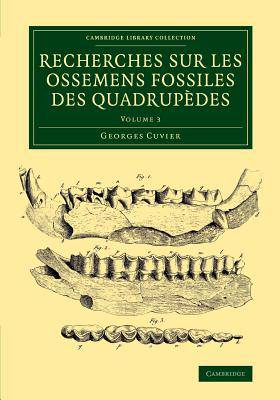
- Afhalen na 1 uur in een winkel met voorraad
- Gratis thuislevering in België vanaf € 30
- Ruim aanbod met 7 miljoen producten
- Afhalen na 1 uur in een winkel met voorraad
- Gratis thuislevering in België vanaf € 30
- Ruim aanbod met 7 miljoen producten
Zoeken
Recherches Sur Les Ossemens Fossiles Des Quadrupèdes
Georges Cuvier
€ 106,45
+ 212 punten
Uitvoering
Omschrijving
Georges Cuvier (1769-1832), one of the founding figures of vertebrate palaeontology, pursued a successful scientific career despite the political upheavals in France during his lifetime. In the 1790s, Cuvier's work on fossils of large mammals including mammoths enabled him to show that extinction was a scientific fact. In 1812 Cuvier published this four-volume illustrated collection of his papers on palaeontology, osteology (notably dentition) and stratigraphy. It was followed in 1817 by his famous Le règne animal, available in the Cambridge Library Collection both in French and in Edward Griffith's expanded English translation (1827-35). Volume 3 of Recherches sur les ossemens fossiles recounts Cuvier's excitement at acquiring fossils from gypsum quarries near Paris, and the challenges of piecing the fragments together correctly. Cuvier describes the methodical reconstruction of the pachyderm fossils and lists other fossils occurring in the same rock formations: carnivores, an opossum, birds, reptiles, and fish.
Specificaties
Betrokkenen
- Auteur(s):
- Uitgeverij:
Inhoud
- Aantal bladzijden:
- 476
- Taal:
- Engels
- Reeks:
Eigenschappen
- Productcode (EAN):
- 9781108083775
- Verschijningsdatum:
- 12/03/2015
- Uitvoering:
- Paperback
- Formaat:
- Trade paperback (VS)
- Afmetingen:
- 178 mm x 254 mm
- Gewicht:
- 816 g

Alleen bij Standaard Boekhandel
+ 212 punten op je klantenkaart van Standaard Boekhandel
Beoordelingen
We publiceren alleen reviews die voldoen aan de voorwaarden voor reviews. Bekijk onze voorwaarden voor reviews.











